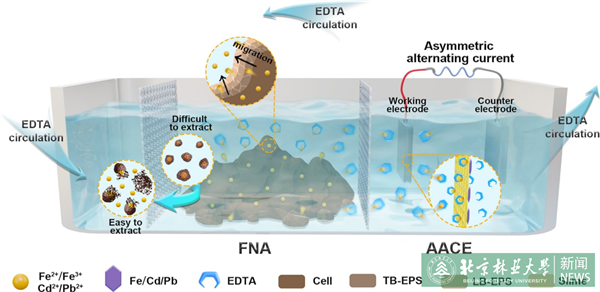Latest news
Recently, the Top environmental journal Water Research (IF=12.8) published the research paper entitled "Free nitrous acid-assisted asymmetrical alternating current electrochemistry (FNA-AACE) for multi-heavy metals decontamination in waste activated sludge" from Professor Wang Yishi from the College of Environmental Science and Engineering. The first author of the paper is Han Zhibo, a graduate of the College and Beijing Forestry University is the signature unit of the first author.

Land application is one of the sustainable disposal routes of waste activated sludge (WAS), which can recover nitrogen, phosphate, and other micronutrients , and has been generally used in the US and Europe because of its low cost. Due to the abundant nutrients in WAS, the fertilizer product from sludge can not only ameliorate the soil structure but also increase the soil nutrient content. However, one of the unwanted effects that challenge its application is the heavy metals pollution in sludge. During land application, heavy metals present in WAS are typically highly toxic or carcinogenic even at trace concentrations and can accumulate in biomass, causing severe environmental pollution and human health risk .
This study proposes a novel free nitrous acid (FNA)-assisted asymmetrical alternating current electrochemistry (FNA-AACE) process to achieve high-efficiency decontamination of multi-heavy metals (Cd, Pb, and Fe) in WAS. The optimal operating conditions, the heavy metal removal performance of FNA-AACE, and the related mechanisms for maintaining the high performance were systematically investigated. During the FNA-AACE process, FNA treatment was optimal with an exposure time of 13 h at a pH of 2.9 and an FNA concentration of 0.6 mg/g TSS. Then the sludge was washed with EDTA in a recirculating leaching system under asymmetrical alternating current electrochemistry (AACE). The 6-h working and the following electrode cleaning were defined as a working circle of AACE. After three cycles of working-cleaning periods in AACE treatment, the cumulative removal efficiency of the toxic metals Cd and Pb reached over 97% and 93%, respectively, whilst that of Fe was greater than 65%. This surpasses most previously reported efficiencies and possesses a shorter treatment duration and sustainable EDTA circulation. The mechanism analysis suggested that FNA pretreatment provoked the migration of heavy metals for leaching enhancement, as well as reduced the demand for EDTA eluent concentration and increased conductivity, which can improve the AACE efficiency. Meanwhile, the AACE process absorbed the anionic chelates of heavy metals and reduced them to zero-valent particles on the electrode, regenerating the EDTA eluent and maintaining its high extraction efficiency for heavy metals. In addition, FNA-AACE could provide different electric field operation modes, allowing it to have flexibility for the real application processes. This proposed process is expected to be coupled with anaerobic digestion in wastewater treatment plants (WWTPs) for high efficiency of heavy metal decontamination, sludge reduction, and resource/energy recovery.
The research received financial support from National Natural Science Foundation of China (nos. 52170122 and 51978054), Project funded by China Postdoctoral Science Foundation (no. 2022M720454) and Beijing Municipal Education Commission through the Innovative Transdisciplinary Program “Ecological Restoration Engineering” (no. GJJXK210102).
Paper link: https://doi.org/10.1016/j.watres.2023.120259










